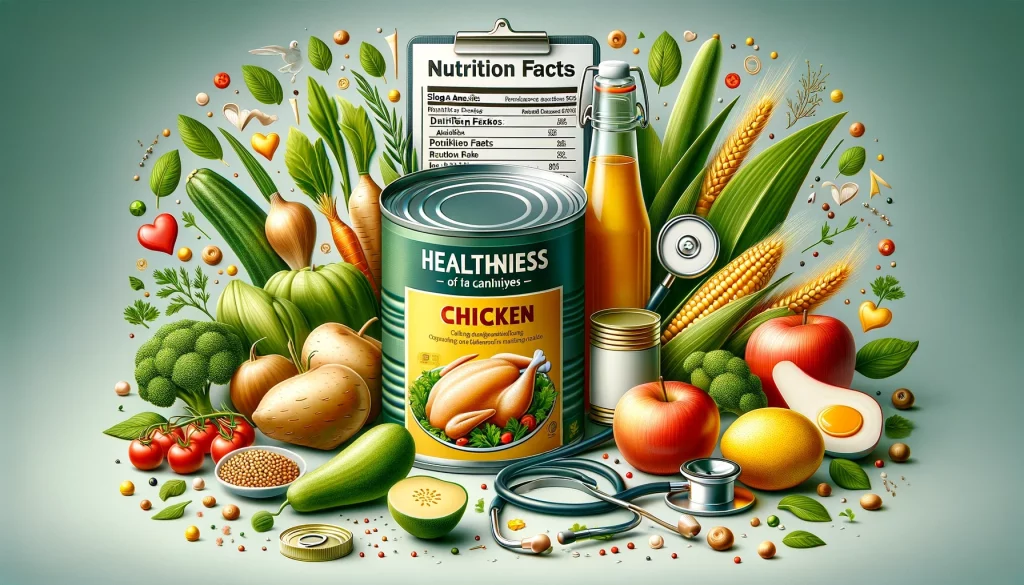|
Getting your Trinity Audio player ready...
|

Table of Contents
Ever found yourself staring at a can of chicken in the grocery aisle, wondering if it’s a shortcut to a healthy meal or just another processed food item? You’re not alone. In a world where convenience often trumps quality, it’s crucial to pause and ponder: Is canned chicken healthy? This question echoes in kitchens across the U.S., from bustling city apartments to cozy suburban homes. Today, we’re going to dissect this query, peeling back the lid to reveal what lies beneath the surface of canned chicken.
What is Canned Chicken?
Canned chicken, a staple that’s found its way into American pantries, is essentially cooked chicken that has been processed, sealed in a can, and subjected to high heat to ensure preservation and safety. I recall my grandmother’s pantry, lined with cans, including the ever-present chicken, which she touted as her emergency meal hero. The journey of canned chicken, from a wartime necessity to a pantry staple, mirrors the evolution of our food industry, where shelf-life and convenience have become paramount.
Walking through the aisles, you’ll find a variety of canned chicken options: some packed in broth, others in water, and even flavored varieties. The choices are as diverse as America itself, but it begs the question – what exactly are we consuming?
Nutritional Profile of Canned Chicken
Nutritionally speaking, canned chicken is a bit of a mixed bag. On one hand, it’s a protein powerhouse. A single serving can pack a punch, providing a substantial amount of your daily protein needs. I remember relying on it during my college days, when cooking time was as scarce as my budget. However, it’s not just about the protein. Canned chicken can come with added preservatives and a hefty dose of sodium – a trade-off for its extended shelf life.
Comparing canned chicken to its fresh counterpart reveals some stark differences. Fresh chicken typically contains less sodium and doesn’t carry the baggage of preservatives. But let’s be real – not everyone has the luxury of time to cook fresh chicken. This is where canned chicken steps in, offering a quick protein fix.
Health Benefits of Canned Chicken
While canned chicken may not be the poster child for health foods, it’s not without its merits. One of the most significant advantages is its high protein content. Protein is the building block of our bodies, essential for muscle repair and growth – a fact any gym-goer or fitness enthusiast can attest to. I remember during a hiking trip in Colorado, canned chicken was a godsend, providing a quick protein fix to replenish after long treks.
Another upside is the convenience factor. In today’s fast-paced world, where time is as precious as health, canned chicken can be a lifesaver. It’s pre-cooked, easy to store, and has a long shelf life, making it an ideal emergency food or a quick meal solution.
Potential Health Concerns
However, it’s not all sunshine and rainbows. The health concerns associated with canned chicken primarily revolve around its high sodium content and the presence of preservatives. High sodium intake is linked to increased blood pressure and heart disease risks. And while preservatives help keep canned chicken safe and shelf-stable, they often raise eyebrows regarding long-term health impacts.
Another concern is Bisphenol A (BPA), commonly found in can linings. There’s ongoing debate and research about BPA’s potential health effects, with some studies suggesting it could affect hormone levels and increase certain health risks.
Canned Chicken in a Balanced Diet
So, how do we balance these pros and cons? The key is moderation and smart choices. If canned chicken is part of your diet, consider rinsing it to reduce sodium content. Also, pairing it with fresh vegetables and whole grains can turn it into a more balanced meal.
It’s also important to consider portion control. Like any processed food, moderation is crucial. Canned chicken can be part of a healthy diet when consumed sensibly and as part of a varied diet.
Comparison with Other Canned Meats
When stacked against other canned meats like tuna or salmon, canned chicken generally has a lower fat content but can be higher in sodium. Tuna and salmon offer omega-3 fatty acids, beneficial for heart health, which canned chicken lacks. However, for those allergic to fish or looking for a milder flavor, canned chicken is an excellent alternative.
Consumer Tips for Choosing Healthy Canned Chicken
Navigating the canned chicken aisle can be daunting. Look for options labeled “low sodium” or “no added preservatives.” Some brands also offer organic or non-GMO canned chicken, which might be preferable for those concerned about food sourcing and additives.
Environmental and Ethical Considerations
Canned chicken’s environmental and ethical implications shouldn’t be overlooked.
The canning process involves significant energy use, and there’s the question of sourcing – how and where the chickens are raised. Consumers increasingly demand transparency and ethical practices in their food sources. It’s worth researching brands that prioritize sustainable and humane farming practices.
Conclusion
As we close the lid on our exploration of canned chicken, it’s evident that this pantry staple is a bit of a paradox. It’s a convenient, protein-rich option that fits into the busy American lifestyle, yet it comes with caveats regarding sodium content, preservatives, and potential BPA exposure. The key takeaway? Canned chicken can have a place in a balanced diet when chosen wisely and consumed in moderation. It’s about making informed choices, understanding the trade-offs, and balancing it with a variety of other healthy foods.
- Is Chobani Healthy? Benefits and Comparisons - April 22, 2024
- Fatty15 Supplement Review – Benefits, Safety, and User Insights - March 22, 2024
- Dime Beauty Reviews – Honest Insights for Radiant Skin - March 20, 2024
